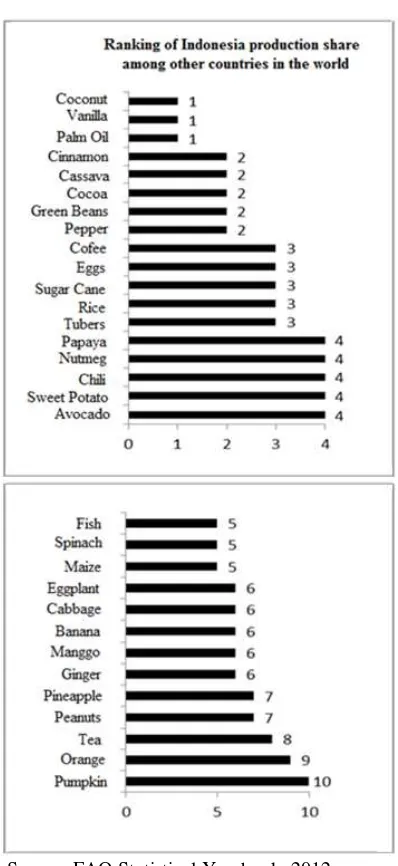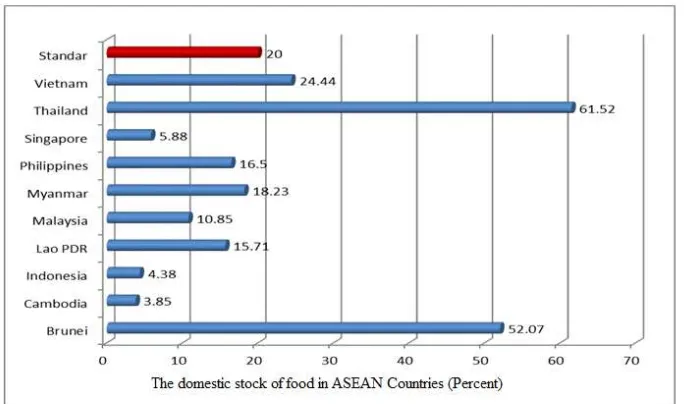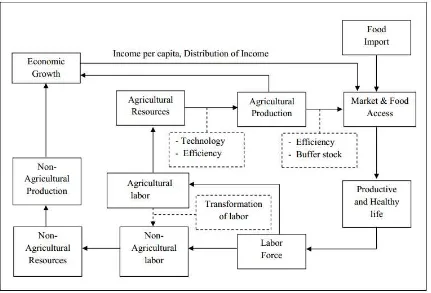Agricultural Socio-Economics Journal Volume XVI, Number 01 (2016): 12-20
DEVELOPMENT OF FOOD SECURITY
IN INDONESIA
Sujarwo
1and Nuhfil Hanani
11Lecturer of Agricultural Economics Department, Agricultural Faculty, University of Brawijaya, Indonesia
*corresponding author: sujarwo.ub@gmail.com
ABSTRACT: Agricultural policy in Indonesia has several steps historically. It is started from land distribution in old-order government of Sukarno. In that time, government focussed on distributing resources and preparing for agricultural development. However, lack of research and development of technology caused low in agricultural production and less food sufficiency. Bringing new perspective of agricultural development, new order government in 1960s brought significant progress in agricultural production in Indonesia but the farmers had to pay cost in depletion of agricultural resources and dependency in chemical fertilizer and pesticides in the production. Currently, more efforts are implemented in sustainable agriculture and diversification in food consumption expecting gains in getting higher nutrition status of individual, braking land conversion and increasing farmers’ income.
Keywords: rice, production, consumption, model, surplus
INTRODUCTION
Currently the case of hunger and malnutrition as one of food insecurity indicators are common in developing countries. In fact, those problems also occur in countries as food producers. In the case of Indonesia, hunger level was 19.7 percent of Indonesia's population in 1990-1992. Many efforts in development initiated by government policy, including family planning and intensification of food crops production, resulted decreasing number of hunger level to 7.9 percent in 2014-2016.
While it has been successful in reducing the number of hungry, Indonesia is still considered relatively slow in reducing the number of undernourished problem, especially children under the age of 5 years. Data 2015 shows that nearly 37 percent of children under five in Indonesia suffered of undernourished problem resulting stunting or physical growing problem due to lack of nutrients.
Regarding historical food policy in Indonesia, the envolution of policies starting from 1955 to 2014 can be identified as several stages. The first stage is food policy regarding food production resources or redistribution of
resources. The second stage is the policy paying more attention on food availability and food access. And, the third stage is the policy focussing on food diversification or food utility.
During the period of development, especially in agricultural development, infrastructure is the major factor boosting the performance. In Soeharto era (new order government), infrastrucure was the major concern in development and became significant factor enhancing not only agriculture sector but also marketing and trading of agricultural products.
Binswanger (1993) observed 13 provinces in India and found that investment in rural infrastructure resulted the lowers transportation costs, improve farmers' access to markets and led to encourage agricultural esxtensification. A World Bank study (1994) showed that the growth of agricultural productivity and non-farm rural employment is closely linked to the provision of infrastructure as well.
Balisacan (2003) also mention other factors beside infrastructure that closely related to the growth and poverty reduction are infrastructure, human capital, agricultural price incentives, and access to technology. The next turn really comes to ensuring the basic need of people which is food security when poverty reduction can be manifested.
Poverty is central of many discussions of development strategies with unique characteristics and its solutions. Indonesia as one of the examples concern in poverty in the priority as high as food security development. What the unique about Indonesia is that food security and poverty reduction are the two things that in the same set of problems. They are related each other. One of the way in solving poverty problems is by strengthening food security in the food availability aspects, enlarging economic activities, and also improving the way how foods are utilized by households. In this sense, people get better livelihood, better income to access foods, and better cooking and consuming food for healty and productive life. Furthermore, government could play important role in implementing and enhancing efective food policy in Indonesia
The question emerge intensely regarding food policy for the next development programs provides discussion regarding food security development for the future. The approach is descriptive analysis and estimates trend and coefficient variance of certain data used. All data uses are secondary from the authorized institutions of Indonesia.
RESULT AND DISCUSSION Poverty in Indonesia
Indonesia had about 237.64 million of total population in 2010 and 171.02 million people of 15 years of age and over (Statistics Indonesia, 2011). Total employment was about 108.21 million people and unemployment rate was 8.32%. Moreover, agricultural sector had the biggest proportion of total population by major
industry in 2010 which was about 38% from the total population of 15 years of ageand over (Statistics Indonesia, 2011). Unfortunately, the share of agricultural sector for GDP decreased starting from 17.8% in 1993 to 15.33% in 2010 (at current market price). So, this proved that there was an indication of low labor productivity in agricultural sector. Moreover, population growth in Indonesia was still high 1.16% in average annually between 2005 and 2010.
Indonesia agricultural sector is dominated by small scale farming. For this case, it will be very difficult to get advantages from economies of scale in farming. Corporate farming introduced by government program in 2000s especially in East Java Province did not run well. Lack of managerial skill in farmer’s institutional level and cultural barrier became the major problem of that program. As a result, increasing labor productivity on agriculture is extremely difficult to be achieved.
Labor transformation from agriculture sector to non-agricultural sector is actually very good way to conquer this problem, unfortunately, it is not easy too since there is not enough fundamental growth of non-agricultural sector to absorb surplus of labor from agriculture. Poor labor productivity in agriculture induces increasing number of poverty.
Poverty is essential problem of food security which limits poor people to access enough food in its quantity and quality for productive and healthy life. In 1990, poverty level in Indonesia was about 9.74 million people in urban area and 17.80 million in rural area. In 2010, the number of poverty was increased about 11.10 million people in urban area and 19.93 million people in rural area. The number of poverty in 1990 was obtained using Indonesian poverty line, which was Rp 20,614 per month/ capita and Rp 13,295 per month/ capita for urban and rural area, respectively. Then, in 2010, the poverty line was increase Rp. 232,989 per month/ capita and Rp. 192,354 per month/ capita for urban and rural area, respectively (Statistics Indonesia, 2011) poverty line which was recommended by World Bank in 2008 is $1.25 per capita/day.
Food policy in Indonesia
not guarantee food security at the individual and household level (Borton and Shoham, 1991).
Sen (1981) againts the Maltusian paradigm that often argued that food insecurity and hunger is a matter of food production and food availability. He realized that adequate food access for individual or family is not a result of availability of aggregate production but it is more related to the way how people individually has access to economic resources for production and generating income, foods distribution, and developing social security and employment entitlement.
It is obvious that food insecurity and hunger happened due to the lack of access to food (lack in income, employment, and other economic resources) even when food production is enough agregately. Therefore, food production is not the sole determinant of food security but it is merely one factor of them.
The incidence of hunger and food insecurity becomes a very sensitive issue in the dynamics of social and political life as Indonesia has. Therefore, government attempts to be able to establish food security up to household and individual level to strengthen political and economic stability.
In this point of view, food security development for combating hunger and undernourisment to ensure expected food security level needs no only how effective macro food policy can be imlemented but also how the domesic food policy can be applied and infuences up to individual level. The final outcome of all those policy is the existence of productive and healthy human resources.
Macro food policy approach for strengtening food securit in Indonesia is deal with many aspects as food supply, food prices, and the dissemination technology to farmers. Historical perspective of food security development in Indonesia noted that there are three basic strategic approach have been conducted which are: (1) redistribution of economic resources including land reform in 1955 during Old Order government; in this time, political stability is the big issue and agriculture still in the lowest level in supplying food need for people. People were suffering much from hungger and the average calories supply away from basic requirements. (2) the food policy shifts then when New Order government coming in 1960s (officially in 1967); the policy has been focused on empowering production technology by implementing green
revolution. However, the policy which has been established for about three decades did not properly develop agriculture as an inportant sector in Indonesia.
Share poverty of farmers in villages area still occurred and labor transformation from agriculture to other sectors in order to prevent arable land fragmentation was unavoidable. However, as noted in many paper about the benefit of green revolution, food availability in Indonesia increased significantly and Indonesia was be able to fullfil self-sufficiency. Moreover, distribution of food and market stability of rice (primary food of Indonesia people) was obligation of National Logistics Agency (BULOG). (3) After New Order development, Reformation era was coming. The food policy pays attention more in food diversification and fullfilling expected food dietary pattern (PPH=pola pangan harapan).
The next food security development faces several challenges regarding sustainability of food production (precision agriculture, green agriculture, market efficiency, and farmers institution issues), food safety to functional food issues, and provision of agricultural research and development.
Existing conditions and problems of food security in Indonesia
Food availability
If the terms of diversity of food crops production,
Indonesia is the second largest after Brazil. It is
estimated about 77 types of plant sources of
carbohydrates, 75 sources of fat, 26 types of beans, 389 types of fruits, 228 types of vegetables, and 110 types of spice plants.
Source: FAO Statistical Yearbook, 2012
Figure 1. Ranking of Indonesia production share among other countries in the world
Food self-sufficiency
Balance of trade for agricultural commodities in Indonesia is presented in Table 1. It appears that the trade balance Food commodities (crops, horticulture, and livestock) is negative, while for the commodities that are generally non-food commodities the balance of trade is positive.
The tabel below is the trade balance of strategic food commodities (Table 2). According Table 2, almost all the trade balance sheet of strategic food commodities are negative. Then, the large amount of negative trade of balance is for soybeans and wheat.
Source: Food Security Agency of Indonesia, 2015
Figure 2. Energy and Protein availability of Indonesia in 2015
Labor transformation from agriculture sector to non-agriculture sector
It has been confirmed empirically that labor transformation in the higher income cuntries is higher on average comparing to that in lower income countries. Labor transformation from agriculture also shows increasing the role of industry, trade, and services sector in the economy. It also means that the economy gets more robust since more sector play their role in generating national income.
initially depend on agriculture, but in line with population growth, transformation of agriculture to non-agriculture happens sucessfully. The relation between proportion of agriculture labor and the income several cuntries is show below.
The transformation of agriculture to non-agriculture in Indonesia is relatively slow compared to other countries, such as South
Korea, Malaysia, and Thailand. This correlates with lower per capita income of Indonesia than that of those countries. Agricultural sector, especially in the food commodities burden to many presure of employment resulting in agricultural involution which is also called ‘shared poverty’due to fragmentation of land and decreasing economic of scale.
Tabel 1. Balance of Trade of agricultural commodities, 2014 Sub Sector Export Value (US$
000)
Import Value (US$ 000)
Balace of Tade (US$)
Food crops 82,865 2,770,157 -2,687,292
Horticulture 255,482 863,614 -608,132
Plantation 14,764,208 1,358,943 13,405,265
Livesock 283,290 1,849,380 -1,566,090
TOTAL 15,385,845 6,842,094 8,543,751
Source: Food Security Agency of Indonesia, 2015
Tabel 2. Neraca Perdagangan Komoditas Pangan Strategis,2014 Komoditas Export Value
(US$ 000)
Import Value (US$ 000)
Balace of Tade (US$)
Wheat 24,317 1,266,686 -1,242,369
Soybean 24,911 787,526 -762,615
Maize 3,538 371,104 -367,566
Peanuts 5,936 179,795 -173,859
Rice 680 63,214 -62,534
Cassava 17,686 34,541 -16,854
Sweet Potato 4,328 39 4,289
Others 1,469 67,252 -65,783
TOTAL 82,865 2,770,157 -2,687,292
Figure 3. Transformation of labor from agriculture to non-agriculture sector
Source: Statistics Indonesia, 2011
Figure 5. Fluctuation of food prices
Source: National economic survey, 2010
Figure 6. The correlation between income and energy consumption
Food reserves
The food reserves of rice in Indonesia is still less than expected which is 20 percent of consumption. Comparing to food reserves in other Asian countries, Indonesia is very low and even lower comparing to Singapore that is not a rice producer.
Food access
products and the correlaton between income and energy and protein consumption is shown in the figures below.
Food diversification and food safety
There is not a clear trend of food diversifcation in the development of food security in Indonesia. PPH (expected food dietary pattern) is about 75.7 percent in 2009 and increasing to 85.6 percent in 2011 but decreasing again to 81.4 percent in 2013. Several programs was conducted by government such as food self-sufficiency in village level with the core program on rural development and enlargement of institutional and economic capacity, subsidy in encouraging local institution and cooperative farmers, and also increasing intensity of yard utilization.
Regarding food safety, Indonesia still has some poisioning incidents. There are two factors dominated the incidents: (1) the presence of pesticide residues in agricultural products: vegetables, fruits, and fresh food; and (2) the use of additives material in foods production. The number of food poisoning cases and victims decreased over years but it is still high (around
150 cases on average). These incidents happened because of lack of government food control.
Food Security development framework
All what the discussion and data provided can be described as Figure – 7. The loop between food security, growth and other sectors shows that one effort for improving performance food security is a result from improving market and food access for all people as consumers and producers as well.
Both agent, producer and consumer gain from market which are market for good and services and also market for labor. Consumers have enough food from market in order to utilize it and get gain of healthy and productive life; therefore, they will provide productive human resource as labor. Producers, both in agriculture and non-agriculture use productive labor due to enough good nutrients from their safet food and their consumption wil create income and economic growth in total. All those aspects of agriculture and non-agriculture link one to others and could be designed as follow.
Volume XVI, Number 01 (2016): 12-20
Agricultural Socio-Economics Journal Volume XVI, Number 01 (2016): 12-20
CONCLUSION AND POLICY SUGGESTIONS
Discussion about food security development should be addressed on food availability, food access, and food utility. Regarding food availability (calories), Indonesia has more than standard that should be provided for all people aggregately. The potential of food energy resources are many but most of the them have not been developed in the way that the consumers are preferred. The delay in the development of food agro-industry as a business transformation of agriculture to non-agricultural sector affects on employment issues and low incomes per capita of Indonesia. Food agro-industry development will have an impact on the business development of food as one of the
drivers of rural industrialization. For food access,
the system of food production that are seasonal,
so requires price stability to maintain the purchasing power of people. Food utility aspect is concerns with dominantly carbohydrates consumption and unbalanced source of energy consumed. Indonesian depend heavily on rice in their daily consumption. Food safety is also the other concern about food policy since the poisoning incident is till high.
Based on these problems, the development of food security should be addressed on: (1) Increasing the availability of food through
increasing productivity and production,
diversification of food crops production both fresh and adding value of processed food. (2) Improving food access of society as an efforts to reduce the food-insecure population through empowering economic and institutional capacity up to village level, encoraging cooperative farmers, increasing availability of market information and integration. (3) Improving the quality of food and diversification of food consumption towards adequate nutritional status of the society. (4) Developing fresh and processed food businesses in order to increase the value-added food products, to reduce unemployment, and to increase incomes.
In order to realize the achieve of food security development, the right strategies are needed. There are six strategies can be used in
the development of food security in Indonesia. They are: (1) Development of diversification of food production considering cooperative farming in the production; (2) Development of food reserves and improving market efficiency; (3) Development of agro-industrial food; (4)
Development of diversification of food
consumption; (5) Improved food security and Indonesia: what do subnational data show?" Bulletin of Indonesian Economic Studies 39(3): 329-351. Borton, J. and J. Shoham. (1991). Mapping
Vulnerability to Food Insecurity: Tentative Guidelines for WFP Offices, mimeo. Study Commissioned by the World Food Programme. London: Relief and Development Institute. FAO (2010). The State of Food Insecurity in the
World : Addressing Food Insecurity In Protracted Crises. Rome
FAO (2003). Proceedings. Measurement and Assessment of Food Devrivation and Undernutrion. International Scientific Symposium. Rome, 26-28 Juni 2002. FAO (2011). Statistical Yearbook 2010. Rome Frank R., Nancy M., Bruce C.l, Laura B., and E.
Kenefick. (1999). Food Security Indicators and Framework for Use in the Monitoring and Evaluation of Food Aid Programs. Bureau for Global Programs, U.S. Agency for International Development (USAID)
Sen, A.K. (1981). Poverty and famines.Oxford, UK, Clarendon.




